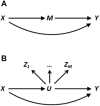Causal mediation analysis with a latent mediator
- PMID: 26363769
- PMCID: PMC5745043
- DOI: 10.1002/bimj.201400124
Causal mediation analysis with a latent mediator
Abstract
Health researchers are often interested in assessing the direct effect of a treatment or exposure on an outcome variable, as well as its indirect (or mediation) effect through an intermediate variable (or mediator). For an outcome following a nonlinear model, the mediation formula may be used to estimate causally interpretable mediation effects. This method, like others, assumes that the mediator is observed. However, as is common in structural equations modeling, we may wish to consider a latent (unobserved) mediator. We follow a potential outcomes framework and assume a generalized structural equations model (GSEM). We provide maximum-likelihood estimation of GSEM parameters using an approximate Monte Carlo EM algorithm, coupled with a mediation formula approach to estimate natural direct and indirect effects. The method relies on an untestable sequential ignorability assumption; we assess robustness to this assumption by adapting a recently proposed method for sensitivity analysis. Simulation studies show good properties of the proposed estimators in plausible scenarios. Our method is applied to a study of the effect of mother education on occurrence of adolescent dental caries, in which we examine possible mediation through latent oral health behavior.
Keywords: Factor analysis; Measurement error; Mediation formula; Monte Carlo EM algorithm; Structural equations model.
© 2015 WILEY-VCH Verlag GmbH & Co. KGaA, Weinheim.
Conflict of interest statement
The authors have declared no conflict of interest.
Figures


References
-
- Albert JM. Mediation analysis via potential outcomes models. Statistics in Medicine. 2008;27:1282–1304. - PubMed
-
- Baron RM, Kenny DA. The moderator-mediator variable distinction in social psychological research: conceptual, strategic, and statistical considerations. Journal of Personality and Social Psychology. 1986;51:1173–1182. - PubMed
MeSH terms
Grants and funding
LinkOut - more resources
Full Text Sources
Other Literature Sources
Medical

